2024年中考英语复习语法复习之名词 课件(共48张PPT)
文档属性
| 名称 | 2024年中考英语复习语法复习之名词 课件(共48张PPT) | 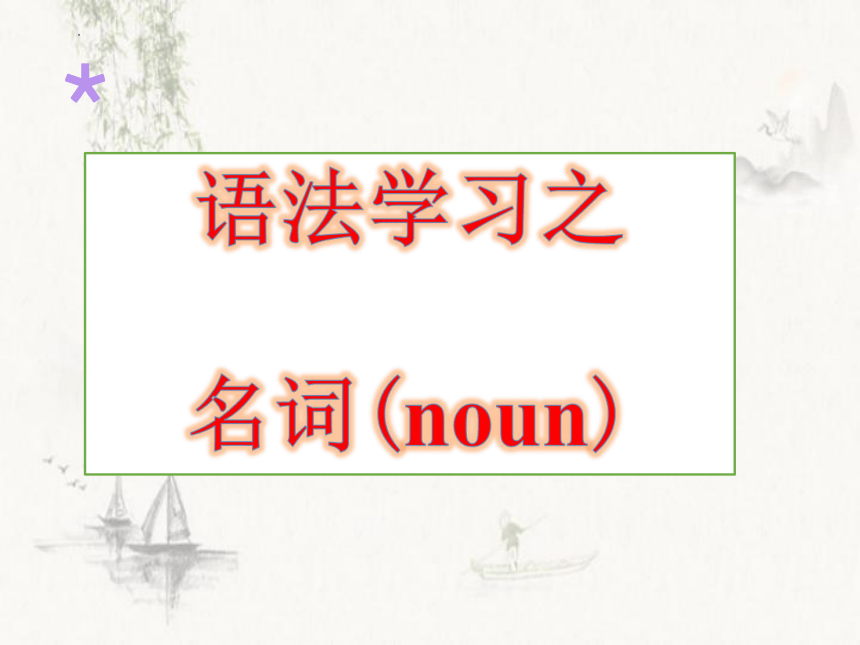 | |
| 格式 | pptx | ||
| 文件大小 | 403.5KB | ||
| 资源类型 | 教案 | ||
| 版本资源 | 人教新目标(Go for it)版 | ||
| 科目 | 英语 | ||
| 更新时间 | 2024-01-23 16:36:29 | ||
图片预览

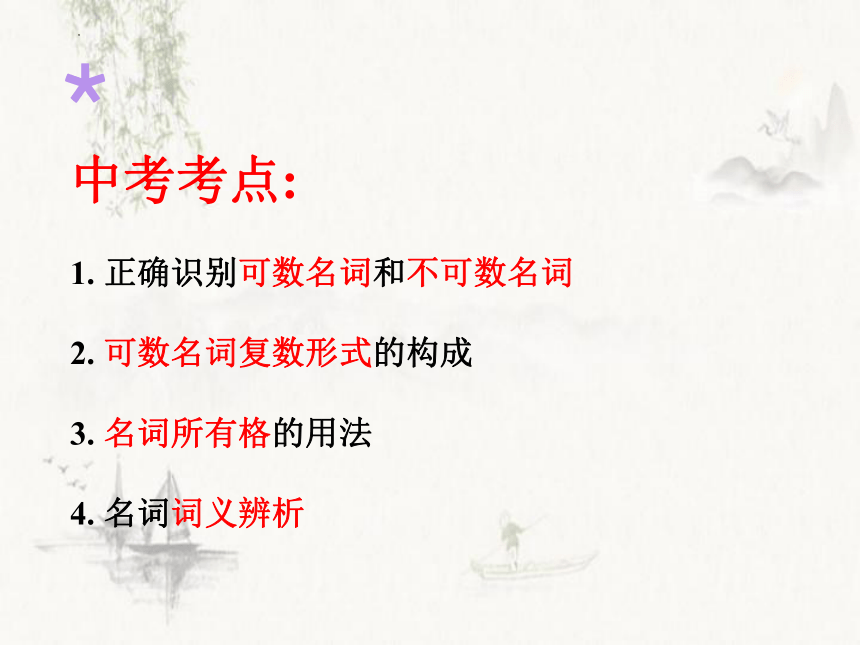


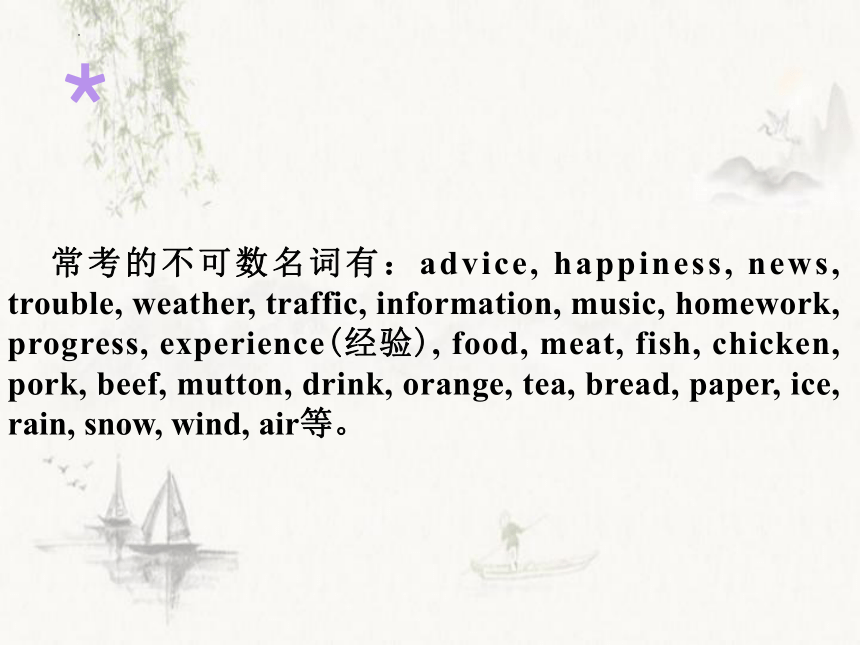
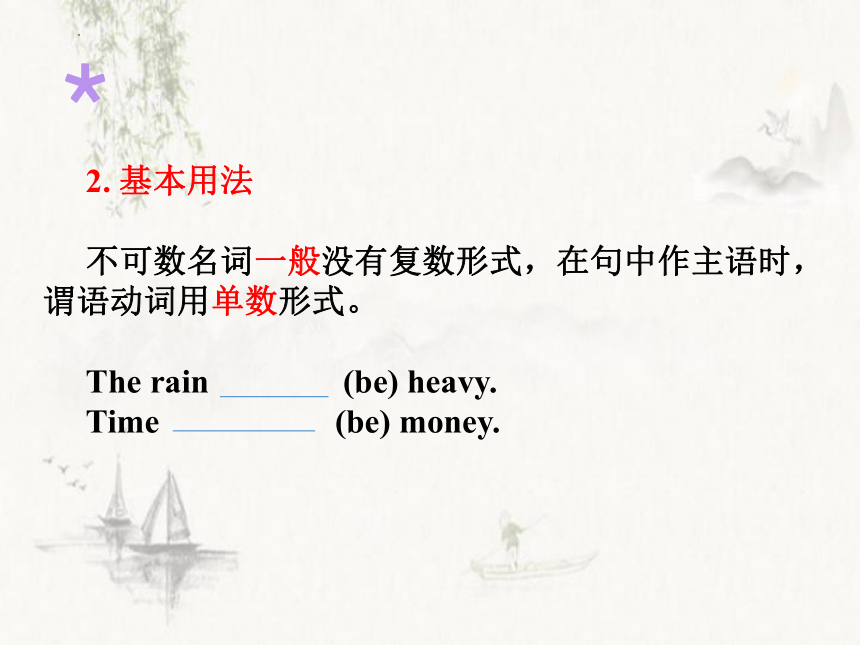
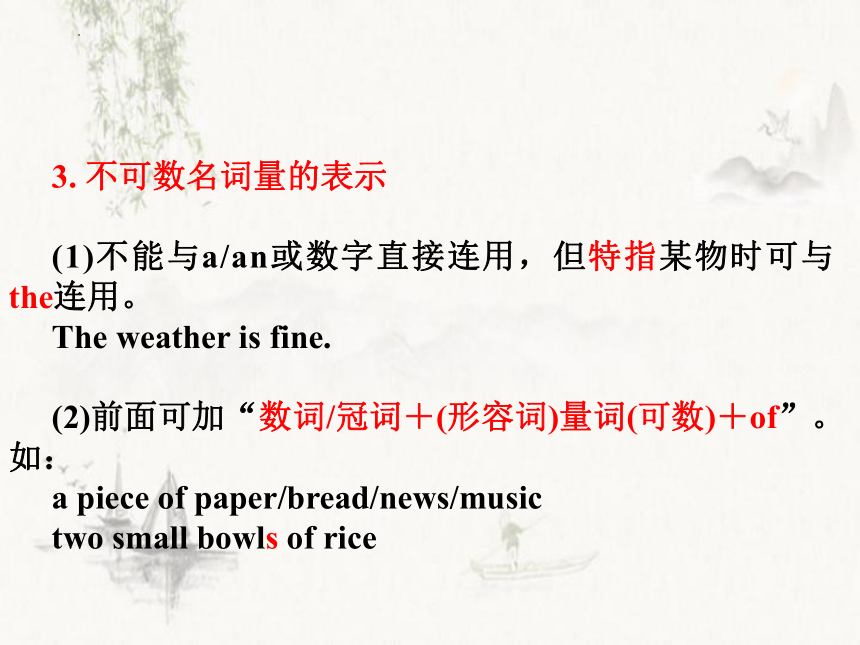
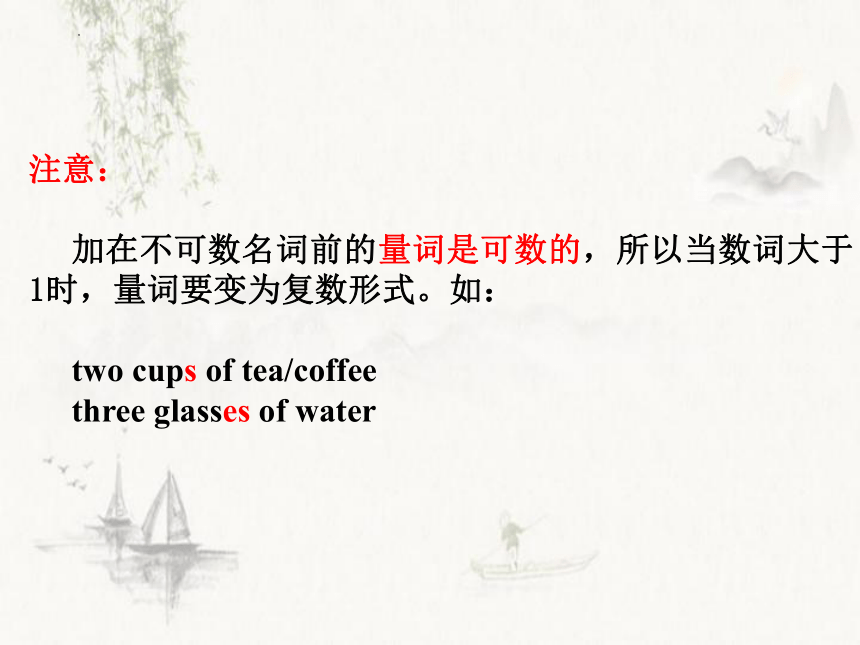
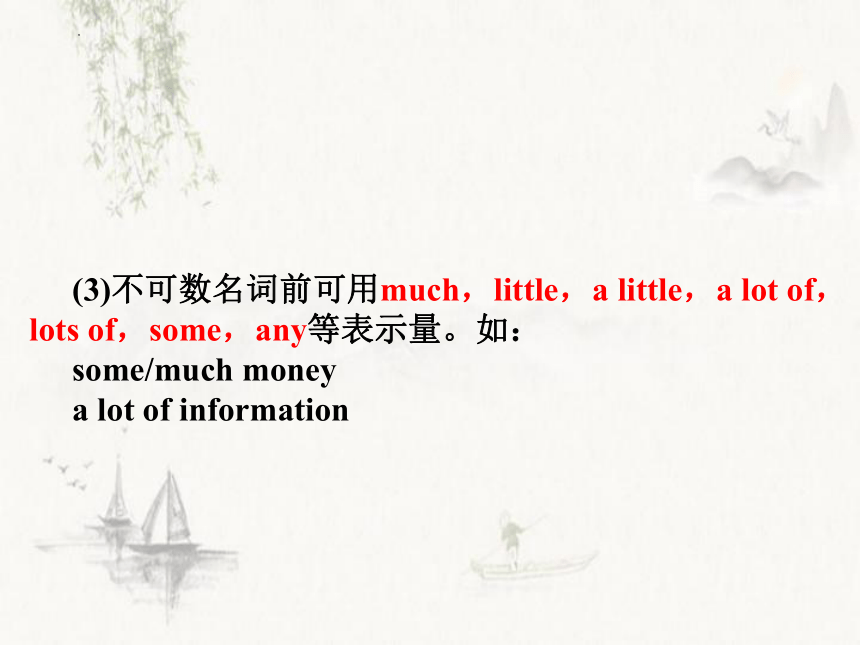

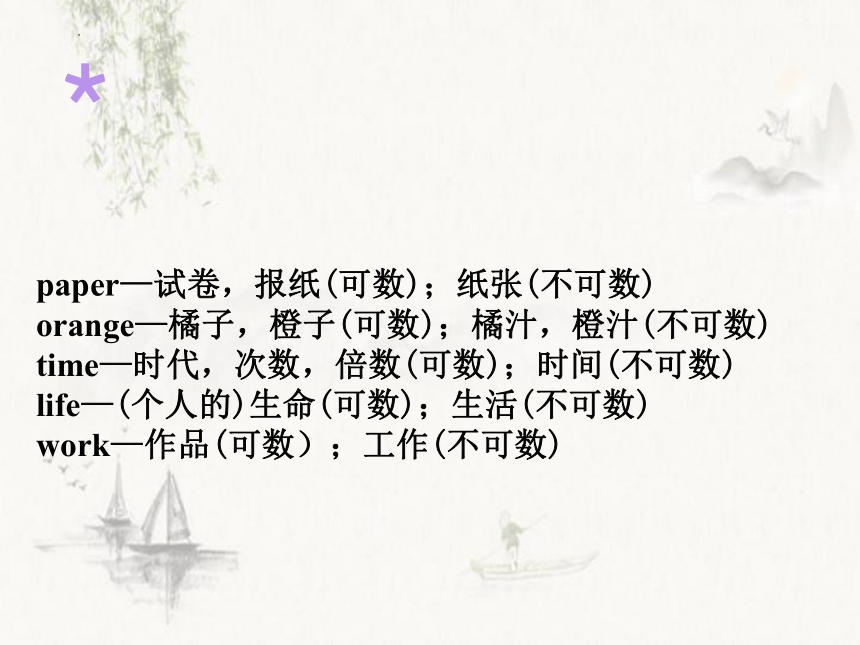
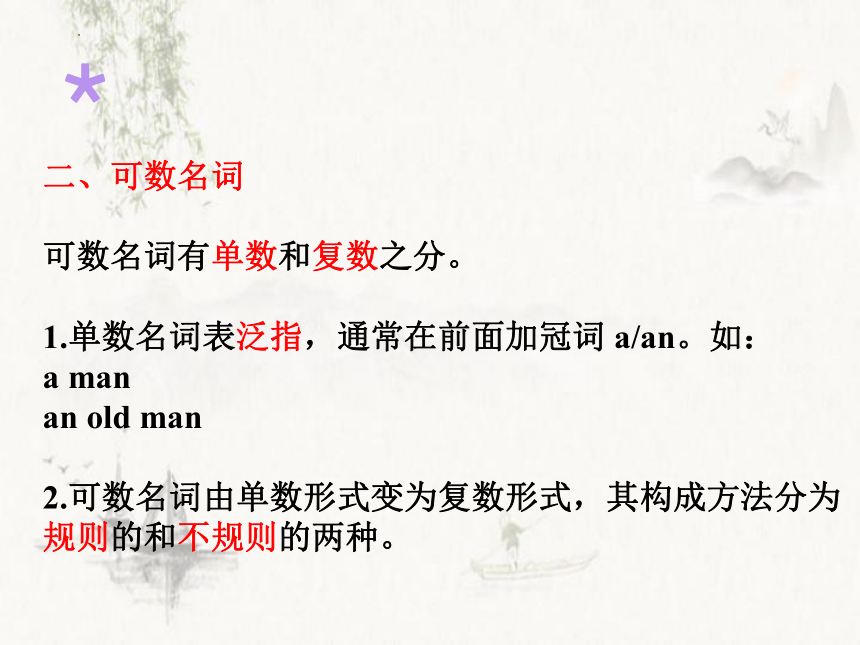
文档简介
(共48张PPT)
语法学习之
名词(noun)
中考考点:
1. 正确识别可数名词和不可数名词
2. 可数名词复数形式的构成
3. 名词所有格的用法
4. 名词词义辨析
PART 01
考点一:不可数名词和可数名词
一、不可数名词
1. 不可数名词的分类
不可数名词分为物质名词(表示无法分为个体的物质,如rice,water,milk等)和抽象名词(表示动作、状态、情况、品质等抽象概念,如work,time,health等)。
常考的不可数名词有:advice, happiness, news, trouble, weather, traffic, information, music, homework, progress, experience(经验), food, meat, fish, chicken, pork, beef, mutton, drink, orange, tea, bread, paper, ice, rain, snow, wind, air等。
2. 基本用法
不可数名词一般没有复数形式,在句中作主语时,谓语动词用单数形式。
The rain (be) heavy.
Time (be) money.
3. 不可数名词量的表示
(1)不能与a/an或数字直接连用,但特指某物时可与 the连用。
The weather is fine.
(2)前面可加“数词/冠词+(形容词)量词(可数)+of”。如:
a piece of paper/bread/news/music
two small bowls of rice
注意:
加在不可数名词前的量词是可数的,所以当数词大于1时,量词要变为复数形式。如:
two cups of tea/coffee
three glasses of water
(3)不可数名词前可用much,little,a little,a lot of,lots of,some,any等表示量。如:
some/much money
a lot of information
4. 既可数又不可数的名词
有些名词既能用作可数名词,又能用作不可数名词,但意义不同。如:
chicken鸡(可数);鸡肉(不可数)
room—房间(可数);空间,余地,地方(不可数)
fish—鱼(可数),fishes(鱼的种类);鱼肉(不可数)
glass—玻璃杯(可数),glasses(眼镜);玻璃(不可数)
paper—试卷,报纸(可数);纸张(不可数)
orange—橘子,橙子(可数);橘汁,橙汁(不可数)
time—时代,次数,倍数(可数);时间(不可数)
life—(个人的)生命(可数);生活(不可数)
work—作品(可数);工作(不可数)
二、可数名词
可数名词有单数和复数之分。
1.单数名词表泛指,通常在前面加冠词 a/an。如:
a man
an old man
2.可数名词由单数形式变为复数形式,其构成方法分为规则的和不规则的两种。
PART 02
考点二:可数名词复数形式的构成
(1)规则变化
①一般是名词直接加-s。如:
cat—cats rose—roses girl—girls
②以“辅音字母+y”结尾的名词,变y为i再加-es。如:
baby—babies city—cities
country—countries factory—factories
family—families party—parties
③以“元音字母+y”结尾的名词,直接加-s。如:
④以s,x,ch,sh 结尾的名词加-es。如:
⑤以o结尾的名词可能加-s,也可能加-es。
巧学妙记:
加-s:小马虎弹着钢琴(piano),听着收音机(radio),又到动物园(zoo)和袋鼠(kangaroo)照相(photo),最后考试得了个大鸭蛋(zero)。
加-es:黑人(Negro)英雄(hero)喜欢吃西红柿 (tomato),土豆(potato)和芒果(mango)。
⑥以f或fe结尾的名词,通常先变 f或fe为v再加-es。
巧学妙记:
树叶 (leaf) 半数 (half) 自己 (self) 黄,
妻子 (wife) 拿刀 (knife) 上山冈,
架 (shelf) 后窜出一只狼 (wolf),
好像强盗 (thief) 逃命 (life) 忙。
注意:
有少数以f或fe结尾的名词构成复数时,只加-s,如:
roofs,gulfs(海湾), chiefs等。但是handkerchief (手帕)和scarf(围巾)的复数可以是handkerchiefs/scarfs,也可以是handkerchieves /scarves。
(2)不规则变化(需记忆)
①改变字母变复数。如:
②表示“某国人”的名词单数变复数:
i. 中国人(Chinese)、日本人(Japanese)、瑞士人(Swiss)单复数同形。
ii. 英国/法国人改a为e。如:
Englishman—Englishmen Frenchman—Frenchmen
iii. 其他以-an,-ian结尾的各国人直接加-s。如:American(s),German(s),Russian(s),Australian(s),Indian(s),Korean(s)。
(3)特殊的复数形式
①有些名词通常只有复数形式,用作主语时谓语动词用复数,如: trousers,pants,shorts,socks,glasses (眼 镜),clothes,chopsticks,scissors,goods (商品)等。
这类名词用来表示数量时,常需加pair(对;双;副),suit(套)等量词。如:a pair of trousers,two pairs of socks,a suit of clothes。
②有些名词单复数同形。如:sheep,deer,people,fish(鱼的数量)等。
③集体名词表示由若干个体组成的集合体,如: class,family,team, group, audience 等。当这类词强调每一个个体成员时,是复数概念,作主语时谓语动词用复数;如果强调整个团体,则视为单数概念,作主语时谓语动词用单数。
My family are watching TV.我的家人正在看电视。
My family is a happy one.我家是一个幸福的家庭。
注意:
有些集体名词通常只用作复数,如:people(人们),
police(警察)等,如果要表达单数形式则要使用其他名词。如:
④由两个名词组成的复合名词变复数时,通常只需将后面这个名词变复数。如:
two apple trees
shoe shops
ten boy students
girl friends
但是,由man,woman作前置定语构成的复合名词变复数时,man或woman与后面的名词都要变复数。如:
two men teachers
some women doctors
注意:
(1)有些名词的单复数形式的意义不同。如:
two fish 两条鱼
two fishes 两种鱼类
some people 一些人
some peoples 一些民族
(2)有些名词形式上是复数,但意义上是单数,一般看作单数名词。如:
news,mathematics,physics,politics,the United States等。
4. 可数名词和不可数名词的修饰语
(1)修饰可数名词的常用修饰语有these,those,few,a few,many,a good/great many,a great/good number of 等。
Few people would agree with this.
He has a great many friends here.
注意:
a good/great many后直接跟名词,不用介词of。但是,若其后所接名词有the,these,my等限定词修饰,则要用介词of,如:
a great many of my friends
(2)修饰不可数名词的常用修饰语有this,that,little, a little,a bit of,much,a great deal of,a large amount of等。
I have little time to do it.
He didn’t give me much money.
A great deal of money is spent on research.
(3)有些修饰语既可修饰可数名词也可修饰不可数名词,如all,some,any,enough,a lot of,lots of,plenty of等。
You needn’t hurry. There’s plenty of time.
There are plenty of men out of work.
PART 03
考点三:名词的所有格
定义:名词所有格用来表示名词和名词之间的所属关系。
1. 有生命的名词的所有格
(1)一般名词(不以-s 结尾)的所有格是在词尾加“’s ”。如:
Lily’s father
mother’s birthday
Children’s Day
men’s clothes
(2)以-s或-es结尾的名词,无论是单数还是复数,其所有格只需在后面加 “ ’ ”。如:
the doctors’ office
the bus’ door
(3)表示“两者(或以上)共同所有”时,只需在最后一个名词后加“’s ”;若表示“两者(或以上)各自拥有”时,要在每一个名词后都加“’s”。如:
Lucy and Lily’s room 露西和莉莉的房间(共同所有, 只有一个房间,room 用单数)
Lucy’s and Lily’s rooms 露西的房间和莉莉的房间(各自拥有一个房间,room 用复数)
(4)在表示“某人的家”、“某种从业者的工作地点(如店铺、诊所、餐馆等)”的名词所有格后面,一般省掉它所修饰的名词。如:
at Mr. White’s (house) 在怀特先生家
at the barber’s (shop) 在理发店
at the doctor’s (office) 在医生的诊所
(5)双重所有格:在表示所属物的名词前有冠词、数词、不定代词或指示代词(如a,two,some,a few, this,that,these,those等)时,用“of+名词所有格”或“of+名词性物主代词”来表示所属关系。如:
2. 无生命的名词的所有格
(1)一些无生命的名词的所有格要用“of ”来表示。如:
a map of China
the foot of the hill
the end of the term
the leaves of the tree
the title of the text
(2)表示时间、距离、长度、重量、价格等名词的所有格要用“’s”来表示。如:
one hundred miles’ journey
a boat’s length
two pounds’ weight
seven days’ holiday
six minutes’ walk
注意:
一些名词表示所属关系时,通常并不使用所有格,而是借助于某些介词。如:
the key to the door
the way to the school
the answer to the question
PART 04
课后作业
一、选择题
1. The students of Grade 7 visited Mike‘s farm and saw many ________there.
A. bird B. duck
C. sheep D. rabbit
2.________ school is quite near the bus station.
A.Ted and Tom's
B.Ted's and Tom's
C.Ted and Tom
3.What are the ________ doing there
—They are busy ________ their science experiment.
A.boys students; to do
B.boy students; to do
C.boys students; doing
D.boy students; doing
4.I'm so hungry. Please give me________ to eat.
A. three bread
B. three pieces of bread
C. three pieces of breads
D. three piece of bread
5.—What's the date today
—It's March 8th, ________ Day.
A. Woman B.Women
C.Woman's D.Women's
二、填空题,用所给词的适当形式填空
1.We should learn from ________ (hero).
2.________(leaf) turn green in spring.
3.Would you like some ________(milk)
4.There ________(be) good news in today's newspaper.
5.The pair of shoes ________(be) very nice. I'll take it.
6.The two ________(boy) jackets are very new.
7.He is a friend of my ________(sister).
8.All the ________(woman) teachers are happy on March 8th.
9.There are several ________ (library) in the city.
10.Here are some ____________ (photo) for you.
11.Those ________ (policeman) are looking for the lost kids.
12.Collecting stamps is one of my ________ (hobby).
13.Many ________ (people) went to the beach last weekend.
14.The food ________ (taste) delicious. I like it very much.
1 heroes 2 Leaves
3 milk 4 is
5 is 6 boys’
7 sister's 8 women
9 libraries 10 photos
11policemen 12 hobbies
13 people 14 tastes
谢谢!
语法学习之
名词(noun)
中考考点:
1. 正确识别可数名词和不可数名词
2. 可数名词复数形式的构成
3. 名词所有格的用法
4. 名词词义辨析
PART 01
考点一:不可数名词和可数名词
一、不可数名词
1. 不可数名词的分类
不可数名词分为物质名词(表示无法分为个体的物质,如rice,water,milk等)和抽象名词(表示动作、状态、情况、品质等抽象概念,如work,time,health等)。
常考的不可数名词有:advice, happiness, news, trouble, weather, traffic, information, music, homework, progress, experience(经验), food, meat, fish, chicken, pork, beef, mutton, drink, orange, tea, bread, paper, ice, rain, snow, wind, air等。
2. 基本用法
不可数名词一般没有复数形式,在句中作主语时,谓语动词用单数形式。
The rain (be) heavy.
Time (be) money.
3. 不可数名词量的表示
(1)不能与a/an或数字直接连用,但特指某物时可与 the连用。
The weather is fine.
(2)前面可加“数词/冠词+(形容词)量词(可数)+of”。如:
a piece of paper/bread/news/music
two small bowls of rice
注意:
加在不可数名词前的量词是可数的,所以当数词大于1时,量词要变为复数形式。如:
two cups of tea/coffee
three glasses of water
(3)不可数名词前可用much,little,a little,a lot of,lots of,some,any等表示量。如:
some/much money
a lot of information
4. 既可数又不可数的名词
有些名词既能用作可数名词,又能用作不可数名词,但意义不同。如:
chicken鸡(可数);鸡肉(不可数)
room—房间(可数);空间,余地,地方(不可数)
fish—鱼(可数),fishes(鱼的种类);鱼肉(不可数)
glass—玻璃杯(可数),glasses(眼镜);玻璃(不可数)
paper—试卷,报纸(可数);纸张(不可数)
orange—橘子,橙子(可数);橘汁,橙汁(不可数)
time—时代,次数,倍数(可数);时间(不可数)
life—(个人的)生命(可数);生活(不可数)
work—作品(可数);工作(不可数)
二、可数名词
可数名词有单数和复数之分。
1.单数名词表泛指,通常在前面加冠词 a/an。如:
a man
an old man
2.可数名词由单数形式变为复数形式,其构成方法分为规则的和不规则的两种。
PART 02
考点二:可数名词复数形式的构成
(1)规则变化
①一般是名词直接加-s。如:
cat—cats rose—roses girl—girls
②以“辅音字母+y”结尾的名词,变y为i再加-es。如:
baby—babies city—cities
country—countries factory—factories
family—families party—parties
③以“元音字母+y”结尾的名词,直接加-s。如:
④以s,x,ch,sh 结尾的名词加-es。如:
⑤以o结尾的名词可能加-s,也可能加-es。
巧学妙记:
加-s:小马虎弹着钢琴(piano),听着收音机(radio),又到动物园(zoo)和袋鼠(kangaroo)照相(photo),最后考试得了个大鸭蛋(zero)。
加-es:黑人(Negro)英雄(hero)喜欢吃西红柿 (tomato),土豆(potato)和芒果(mango)。
⑥以f或fe结尾的名词,通常先变 f或fe为v再加-es。
巧学妙记:
树叶 (leaf) 半数 (half) 自己 (self) 黄,
妻子 (wife) 拿刀 (knife) 上山冈,
架 (shelf) 后窜出一只狼 (wolf),
好像强盗 (thief) 逃命 (life) 忙。
注意:
有少数以f或fe结尾的名词构成复数时,只加-s,如:
roofs,gulfs(海湾), chiefs等。但是handkerchief (手帕)和scarf(围巾)的复数可以是handkerchiefs/scarfs,也可以是handkerchieves /scarves。
(2)不规则变化(需记忆)
①改变字母变复数。如:
②表示“某国人”的名词单数变复数:
i. 中国人(Chinese)、日本人(Japanese)、瑞士人(Swiss)单复数同形。
ii. 英国/法国人改a为e。如:
Englishman—Englishmen Frenchman—Frenchmen
iii. 其他以-an,-ian结尾的各国人直接加-s。如:American(s),German(s),Russian(s),Australian(s),Indian(s),Korean(s)。
(3)特殊的复数形式
①有些名词通常只有复数形式,用作主语时谓语动词用复数,如: trousers,pants,shorts,socks,glasses (眼 镜),clothes,chopsticks,scissors,goods (商品)等。
这类名词用来表示数量时,常需加pair(对;双;副),suit(套)等量词。如:a pair of trousers,two pairs of socks,a suit of clothes。
②有些名词单复数同形。如:sheep,deer,people,fish(鱼的数量)等。
③集体名词表示由若干个体组成的集合体,如: class,family,team, group, audience 等。当这类词强调每一个个体成员时,是复数概念,作主语时谓语动词用复数;如果强调整个团体,则视为单数概念,作主语时谓语动词用单数。
My family are watching TV.我的家人正在看电视。
My family is a happy one.我家是一个幸福的家庭。
注意:
有些集体名词通常只用作复数,如:people(人们),
police(警察)等,如果要表达单数形式则要使用其他名词。如:
④由两个名词组成的复合名词变复数时,通常只需将后面这个名词变复数。如:
two apple trees
shoe shops
ten boy students
girl friends
但是,由man,woman作前置定语构成的复合名词变复数时,man或woman与后面的名词都要变复数。如:
two men teachers
some women doctors
注意:
(1)有些名词的单复数形式的意义不同。如:
two fish 两条鱼
two fishes 两种鱼类
some people 一些人
some peoples 一些民族
(2)有些名词形式上是复数,但意义上是单数,一般看作单数名词。如:
news,mathematics,physics,politics,the United States等。
4. 可数名词和不可数名词的修饰语
(1)修饰可数名词的常用修饰语有these,those,few,a few,many,a good/great many,a great/good number of 等。
Few people would agree with this.
He has a great many friends here.
注意:
a good/great many后直接跟名词,不用介词of。但是,若其后所接名词有the,these,my等限定词修饰,则要用介词of,如:
a great many of my friends
(2)修饰不可数名词的常用修饰语有this,that,little, a little,a bit of,much,a great deal of,a large amount of等。
I have little time to do it.
He didn’t give me much money.
A great deal of money is spent on research.
(3)有些修饰语既可修饰可数名词也可修饰不可数名词,如all,some,any,enough,a lot of,lots of,plenty of等。
You needn’t hurry. There’s plenty of time.
There are plenty of men out of work.
PART 03
考点三:名词的所有格
定义:名词所有格用来表示名词和名词之间的所属关系。
1. 有生命的名词的所有格
(1)一般名词(不以-s 结尾)的所有格是在词尾加“’s ”。如:
Lily’s father
mother’s birthday
Children’s Day
men’s clothes
(2)以-s或-es结尾的名词,无论是单数还是复数,其所有格只需在后面加 “ ’ ”。如:
the doctors’ office
the bus’ door
(3)表示“两者(或以上)共同所有”时,只需在最后一个名词后加“’s ”;若表示“两者(或以上)各自拥有”时,要在每一个名词后都加“’s”。如:
Lucy and Lily’s room 露西和莉莉的房间(共同所有, 只有一个房间,room 用单数)
Lucy’s and Lily’s rooms 露西的房间和莉莉的房间(各自拥有一个房间,room 用复数)
(4)在表示“某人的家”、“某种从业者的工作地点(如店铺、诊所、餐馆等)”的名词所有格后面,一般省掉它所修饰的名词。如:
at Mr. White’s (house) 在怀特先生家
at the barber’s (shop) 在理发店
at the doctor’s (office) 在医生的诊所
(5)双重所有格:在表示所属物的名词前有冠词、数词、不定代词或指示代词(如a,two,some,a few, this,that,these,those等)时,用“of+名词所有格”或“of+名词性物主代词”来表示所属关系。如:
2. 无生命的名词的所有格
(1)一些无生命的名词的所有格要用“of ”来表示。如:
a map of China
the foot of the hill
the end of the term
the leaves of the tree
the title of the text
(2)表示时间、距离、长度、重量、价格等名词的所有格要用“’s”来表示。如:
one hundred miles’ journey
a boat’s length
two pounds’ weight
seven days’ holiday
six minutes’ walk
注意:
一些名词表示所属关系时,通常并不使用所有格,而是借助于某些介词。如:
the key to the door
the way to the school
the answer to the question
PART 04
课后作业
一、选择题
1. The students of Grade 7 visited Mike‘s farm and saw many ________there.
A. bird B. duck
C. sheep D. rabbit
2.________ school is quite near the bus station.
A.Ted and Tom's
B.Ted's and Tom's
C.Ted and Tom
3.What are the ________ doing there
—They are busy ________ their science experiment.
A.boys students; to do
B.boy students; to do
C.boys students; doing
D.boy students; doing
4.I'm so hungry. Please give me________ to eat.
A. three bread
B. three pieces of bread
C. three pieces of breads
D. three piece of bread
5.—What's the date today
—It's March 8th, ________ Day.
A. Woman B.Women
C.Woman's D.Women's
二、填空题,用所给词的适当形式填空
1.We should learn from ________ (hero).
2.________(leaf) turn green in spring.
3.Would you like some ________(milk)
4.There ________(be) good news in today's newspaper.
5.The pair of shoes ________(be) very nice. I'll take it.
6.The two ________(boy) jackets are very new.
7.He is a friend of my ________(sister).
8.All the ________(woman) teachers are happy on March 8th.
9.There are several ________ (library) in the city.
10.Here are some ____________ (photo) for you.
11.Those ________ (policeman) are looking for the lost kids.
12.Collecting stamps is one of my ________ (hobby).
13.Many ________ (people) went to the beach last weekend.
14.The food ________ (taste) delicious. I like it very much.
1 heroes 2 Leaves
3 milk 4 is
5 is 6 boys’
7 sister's 8 women
9 libraries 10 photos
11policemen 12 hobbies
13 people 14 tastes
谢谢!
同课章节目录
- 词法
- 名词
- 动词和动词短语
- 动词语态
- 动词时态
- 助动词和情态动词
- 非谓语动词
- 冠词
- 代词
- 数词和量词
- 形容词副词及其比较等级
- 介词和介词短语
- 连词和感叹词
- 构词法
- 相似、相近词比较
- 句法
- 陈述句
- 一般疑问句和否定疑问句
- 特殊疑问句及选择疑问句
- 反意疑问句
- 存在句(There be句型)
- 宾语从句
- 定语从句
- 状语从句
- 主谓一致问题
- 简单句
- 并列句
- 复合句
- 主谓一致
- 主、表语从句
- 名词性从句
- 直接引语和间接引语
- 虚拟语气
- 感叹句
- 强调句
- 倒装句
- 祈使句
- 句子的成分
- 句子的分类
- 题型专区
- 单项选择部分
- 易错题
- 完形填空
- 阅读理解
- 词汇练习
- 听说训练
- 句型转换
- 补全对话
- 短文改错
- 翻译
- 书面表达
- 任务型阅读
- 语法填空
- 其他资料
